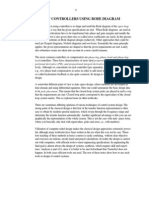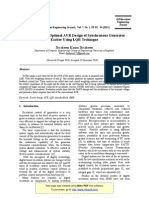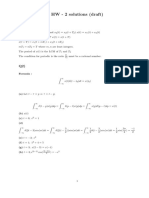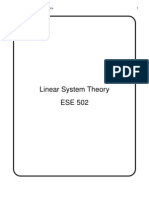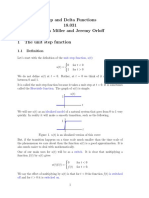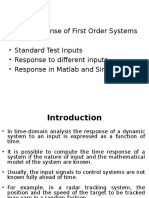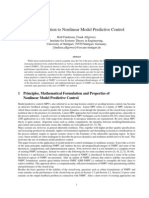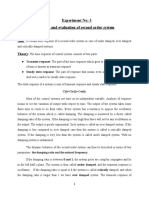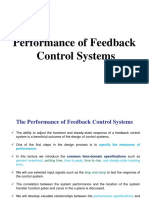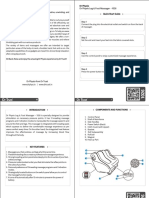EXPERIMENT -1
TIME RESPONSE OF 2ND ORDER CONTROL SYSTEM
AIM: To study the time response of a 2nd order control system.
APPARATUS:
1 Function generator 1
2 Decade resistance box 1
3 Decade inductance box 1
4 Decade capacitor box 1
5 Connecting wires.
6 CRO with probes 2
7
CIRCUIT DIAGRAM:
C(s)
Gain
Time
constan
t
Block diagram of 2nd order system
Time
constan
t
R(s)
�THEORY:
2nd order control systems are characterized by two poles and two zeros.
For the purpose of transient response studies usually zeros are not considered
primarily because of simplicity in calculation and also because the zeros do not
affect the internal modes of the systems. Overall transfer function of 2 nd order
system in standard form is given by.
T(s) =C(s)/R(s) =n2/ (s2+2n s+n2)
Where is called the damping ratio and n the undamped natural frequency. In
order to analyze the transient and steady state behavior of control systems, the
first step always is to obtain a mathematical model of the system then dynamic
behavior is analyzed under application of standard test signals. Step signal is
generally used for testing as it can be easily generated.
The time response performance is measured by computing time response performance
indicates given below.
1
Delay time (td):- It is the time required for the response to read 50% of the final
value in first attempt.
Rise time (tr):- It is the time required for the response to rise from 10% to 90% of
the final value for over damped systems and 0 to 100% of the final value for
underdamped systems.
tr = [ - tan 1 {(1-2)/ }] / wn (1- 2)
Peak time (tp):- It is the time required for the response to reach the peak of time
response or the peak overshoot.
tp = / wn (1- 2)
4
Peak overshoot (MP) :- It indicates the normalized difference between the time
response peak and the steady output and is defined as
Mp = e - / (1-2)
Settling time (ts):- It is the time required for the response to reach and stay within
a specified tolerance band (usually 2% or 5%) of its final value.
For tolerance band of 2% = 4 / wn
For tolerance band of 5% = 3/ wn
Steady State error (ess):- it indicates the error between the actual and desired
output as t tends to infinity.
ess = Lim [ 1 c(t) ]
t->
PROCEDURE:
1 Make the connections as shown in figure.
2 Square wave input of 2 V P-P is given from function generator.
3 Adjust the oscillator frequency to 1 KHz with square waveform as output.
4 CRO probes are connected in series with the above circuit.
5. obtain the input and output waveform in CRO and trace them by calculating T r, Td, Tp,
%MP, Ts etc.
OBSERVATIONS:
S.No.
Resistance Damping
(in ohms) ratio
Tr (sec)
Ts (sec)
%MP
Theoretica
l
%MP
practical
�CALCULATIONS:
Rise time Tr = - tan
Peak time TP = /n
12 / En1
-1
1 2
1 2
Settling time, Ts = 4/ n
% MP = 100 exp (-/
1 2
MODEL GRAPH / WAVEFORMS:
1V
t (mS)
-1 V
T = 1 mS
Step input waveform.
SELF ASSESSMENT QUESTIONS:
1. What is the effect of adding pole and zero on system performance?
2. Does the steady state error depend on the type of system?
3. What is the significance of the damping factor?
4. Is it possible to fide out the time response of higher order systems? Justify your
statement.
RESULT:
